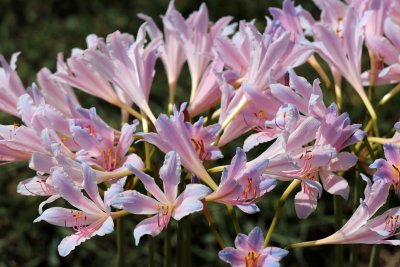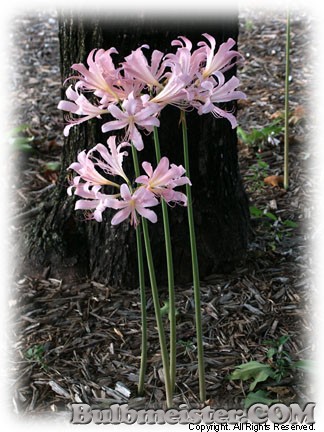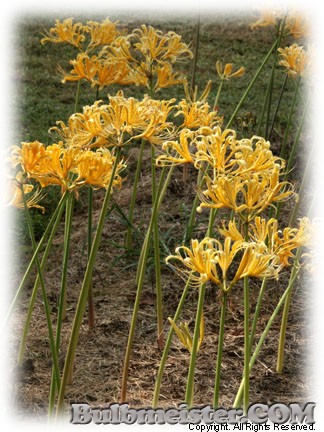testing usability with latest server update...
 This is just a test.
This is just a test.
Why Buy Surprise Lilies from the Bulbmeister?
Friends,
 If you enjoy growing flower bulbs in your landscape, you are also likely aware that the more unusual the species, the more costly it can be. So, the wise thing to do is to shop around if you want one. The genus, Lycoris, first entered the United States of America in 1854, so surprise lilies, or spider lilies, have been in the U.S. well over 150 years. Yet, this exceptionally beautiful genus is not experiencing widespread cultivation. I believe the reason is due to the fact that it is not suited well to the average gardener and non-gardener. Why? Foliage growth is not associated with bloom, so the foliage is likely mowed or cut down too early in the spring, and no plant will do well if its source of photosynthesis is cut short over and over, year after year. Lycoris foliage needs to be allowed to begin to “die back” or dwindle before cutting it back to the ground, allowing as many resources for the development, growth, and division of the bulb, as well as encouraging floral initiation.
If you enjoy growing flower bulbs in your landscape, you are also likely aware that the more unusual the species, the more costly it can be. So, the wise thing to do is to shop around if you want one. The genus, Lycoris, first entered the United States of America in 1854, so surprise lilies, or spider lilies, have been in the U.S. well over 150 years. Yet, this exceptionally beautiful genus is not experiencing widespread cultivation. I believe the reason is due to the fact that it is not suited well to the average gardener and non-gardener. Why? Foliage growth is not associated with bloom, so the foliage is likely mowed or cut down too early in the spring, and no plant will do well if its source of photosynthesis is cut short over and over, year after year. Lycoris foliage needs to be allowed to begin to “die back” or dwindle before cutting it back to the ground, allowing as many resources for the development, growth, and division of the bulb, as well as encouraging floral initiation.
There are some very easy solutions to avoid improper care of the foliage in the winter and spring.
- If planting in the lawn, plant around the base of deciduous trees or fixed objects like fences and gas meters, so, that when mowing in the spring, the foliage is more easily avoided, even if hiring out the mowing to folks who wouldn’t know better. Curséd weed wackers! Optionally, intermingle with a daffodil planting, because the leaves from afar don’t look that much different than daffodil leaves, and everybody knows not to cut down daffodil foliage until 6 weeks after bloom, right? Right?
- If planting in a flower bed, again they can be intermingled with daffodils, but they can also be planted under small trees or in other locations where foliage is enhanced by nearby plants that bloom during that same period of time.
Why go to the trouble of growing Lycoris, if you consider the above explanations to be extraordinary efforts?
Of how many flower bulb genera do you know that provide a prominent, colorful, hawk moth & hummingbird attracting bloom anywhere from the end of July onward into October (depending on variety/species)? The answer would be very few. Color! Prominent Color! And flower form can go from “spidery” to “trumpety".
I trust you will agree at this point that surprise lily just might be worth the effort it takes to strategically locate it in your landscape, but price can and should always be a consideration when buying plants for the landscape. Lycoris are significanly more expensive than commonly purchased bulbs like Muscari, Narcissus (daffodils) and tulips, but there’s a good reason for that. A Lycoris bulb takes at least THREE years to develop from seed or scale before it becomes blooming size. So, it, therefore, requires more time in the nursery before it can be presented to you as a blooming size bulb. Time is resources! Time is money! I will note here that vendors who sell Lycoris in pots are selling you a product that will not likely bloom for at least two more years. Dormant importers may sell you a flowering size bulb, but the way it was prepared for transport affects its ability to recover and may still lead to a delay of a couple years, if not more. Essentially, the bulbs really need to still keep their roots during dormancy, and the roots would not survive the long process of import into the U.S.
 So, why buy from Bulbmeister, really?
So, why buy from Bulbmeister, really?
All of my Lycoris are field grown, and I dig the bulbs on demand. This allows me to select flowering size bulbs with roots, and it allows you to receive them in as fresh a condition as possible. That’s not all, though! In addition to supplying a superior product compared to any other vendor, my prices are significantly lower than any of the vendors who offer bulbs with roots in pots (remember, with Lycoris, roots are important). My prices are even comparable and can be better than those more commonly available as dormant imports.
So, when purchasing Lycoris from the Bulbmeister, you get:
- Flowering sized
- With roots
- Fresh as a daisy
- Comparably GREAT prices!
Okay, folks! I’m going to say it. But that’s not all! Here’s the most important conclusion for considering this investment.
Lycoris bulbs are perennial and slowly divide (increase). This means you will be buying a flower bulb that gives and keeps on giving! As a matter-of-fact, it is recommended you dig every 7-10 YEARS to divide and spread out the established mass of bulbs. That’s not because you subscribed to an annual Lycoris delivery service! No way! No how! That’s because you loved and respected the unique qualities of Lycoris, so it rewarded you in return, year after year after year for FREE.
Buy from the Bulbmeister! I try my hardest, relying on nobody else but myself, to provide you a quality addition to your landscape.
As of the time of this writing, my already competitive prices are slashed on most Lycoris (surpise, resurrection, hurricane, magic, spider lily)! These special prices will remain in effect through July 4, 2019. I’ve also included Canna and Zephyranthes in this sale. Please do consider the Bulbmeister, and thank you for your time.
I do have to end with a bit of bad news for some. Due to the fact my bulbs are field grown and do have roots, I am unable to serve the state of California.
FreezePruf™ - A Quick Summary
I ended my winter 2010 evaluation of Lycoris hardiness with the following statement, “This product will probably be applied again next year in the hopes of evaluating under more normal circumstances and with a properly timed second application.” The “product” referred to was FreezePruf™, an organic solution sprayed on winter plants, touted to improve plant cold hardiness by as much as 9°F.
The winter ending 2011 was in no way a normal winter, instead offering up winter lows that matched the record for our area. I also did not follow my own advice, but modified it. I still sprayed the first application of the solution at the appropriate time, but, shortly after, I covered my Lycoris in Reemay, which is only supposed to protect plants by another 2°F or so. My logic was to provide better protection than I had the year before, especially by offering a frost barrier, where I had only sprayed once, and avoid having to spray again in January/February. Little did I expect the temperatures we would see.
Thankfully, with those temperatures also came snow, which acts as a good insulator. This protected the bulbs, themselves, from actually getting as cold as outside air temperatures, but I was not sure what would happen to the foliage separated from the snow only by a thin layer of Reemay.
For the most part, things went really well. Lycoris xalbiflora performance was disappointing, though, as the foliage did not survive well, even though it performed sufficiently well the year before down to 0°F. Lycoris aurea, treated differently, still sprayed once, but using heated plastic tunnels instead of Reemay, just could not handle the cold, and performed the same as the previous year. This time the heat lamps did not fail, but could not compete with -15°F. Under the Reemay, L. ‘Cherry Blossom Pink’ and L. straminea did not perform well, either. Otherwise, Lycoris foliage performance was as good or better than the previous year, that year’s results of which can be reviewed in detail in the article, “A Practical Evaluation of FreezePruf™“.
My hopes are that this winter will behave more “normally", but whether or not it does, due to the extreme nature of the past two winters, I am convinced FreezePruf™ must become a standard part of my winter Lycoris maintenance program. Thanks to all those who have worked to develop such a product, as it has really served me well in this unique situation.
Improving Winter Hardiness Of Winter Foliage Lycoris
Sometime in the summer of 2009, I was made aware of a new product coming to market, offered under the label, “FreezePruf™“, which was touted to be able to protect, by a difference of over 9°F, plants susceptible to winter damage. As an example, by definition, if I was growing a plant that would receive cell damage starting at 32°F, the use of this product would protect the plant from the same damage down to under 23°F. Well! Now, I thought to myself, “Wouldn’t it be great if this product really works and could protect some of my winter foliage Lycoris from significant winter injury?” I decided to order a gallon of this product, enough to make 4 gallons of solution, and test it on a number of my small Lycoris plots this winter. Little did I know our region of the country would be the recipient of some of the coldest temperatures we have seen in 15 years. But, that’s getting ahead of the story.
The detailed report can be read under the title, “A Practical Evaluation of FreezePruf™“, in the “Growing Guide” section of the Bulbmeister.COM website. The information will include generalized temperature data and environmental conditions, as well as the procedure followed. Additionally, 14 other plots are featured.
Following are images and descriptions of the worst and best performing accessions in the study. Photographs and evaluations were taken on January 18, 2010.
WORST CASE |
BEST CASE |
OUCH! This most tender member of the Lycoris clan proved it needed far more than a spray protectant to survive. Foliage was completely burned back. This plot was in open ground in full sunlight. |
This open ground plot in full sun received minimal damage, one of the most impressive subjects in the trial, with foliage even more upright than other plots. Please note that the residue of the first treatment is still obviously present on the foliage. |
CONCLUSIONS
Realizing that this is only a practical, subjective study, I believe FreezePruf™ deserves further evaluation by myself as a nursery grower. Based upon the expected behavior of the Lycoris radiata group and L. xalbiflora, I have noted what appears to be significant protection from very drastic low temperatures, not normally recorded for this area of the country. Additionally, a proper application to the underside of the foliage was not feasible, nor was the scheduled second application possible before the lowest temperatures were observed. An additional application was applied to surviving plots on January 18th after the photographs were taken. This product will probably be applied again next year in the hopes of evaluating under more normal circumstances and with a properly timed second application.
Things Happening At Bulbmeister Nursery
This season has been great for Lycoris breeding evaluation. Bloom was especially good this year with all my spring foliage species and hybrids, I have selected over 60 plants for further evaluations and use as breeding stock. All selections are from established plots and mainly show species variation with some natural crosses that would have occurred before I acquired the stock. These will be dug, hopefully this week, and either given special plots or potted until a suitable site can be established. Additionally a number of primary and cultivar crosses were performed, making for the second year of organized effort in developing new hybrids. Seed stalks have been harvested and will be allowed to fully mature in the packing room. The seed will then be harvested and immediately planted. So, how does one properly germinate a shiny, black, round Lycoris seed?
- Sow immediately after harvest (if the seed coat starts looking dull, germination becomes more difficult).
- Prepare a seedling flat or pot with seedling medium or standard potting soil. Alternatively, prepare a seed bed in a location that is shady and protected from above ground and underground rodents; a cold frame with wire mesh barriers 4-6″ under the ground, for example.
- Wet the medium thoroughly then press the seeds into the medium, but only enough to stabilize the seed in the location; do not bury in the medium. I do successfully use 1/4″ of granite grit over the top of this setup with excellent success because it helps with moisture control.
- If using pots or flats, provide a “terrarium” environment making into a mini greenhouse. This can be done with clear plastic storage bags and even cling wraps. Sometimes a support might be required using bent wire to make mini hoops. Open ground will need regular light moisture.
- With the seed flat/pot setup, watering should only be necessary minimally through the fall and winter. If condensation quits developing on the surface of the clear plastic, it is too dry.
- If the Lycoris seed you are planting is fully hardy in your area, additional protection should not be required, but I like to have a location that can be kept above freezing. This will be a necessity for fall foliage Lycoris.
- Finally, as an emphasis to point 2, KEEP POTTED SEEDS OUT OF DIRECT SUNLIGHT. Leaving them in direct sunlight will create a little stove that cooks the seeds.
All viable Lycoris seed will send down a root within a few weeks after planting. Fall foliage Lycoris may get a single leaf at this time, too. Spring foliage seedlings will only send up a leaf the following spring. Once the seedlings have gone through a foliage “cycle", they can be treated like other Lycoris, but, being young, it is especially helpful to avoid hot/cold extremes and protect from rodent damage. It can take anywhere from 3-5 years, under ideal conditions, to see a seedling flower. Afternoon shade is always a good thing. So, my Lycoris plots have been the bulk of my focus this season, besides trying to spend more time with my family. I expect to be digging and replanting a number of flower bulb species and varieties by the end of October, which could bring on a special sale from Bulbmeister.COM. Current customers and notification requesters will be alerted if the opportunity arises.
:: Next >>


